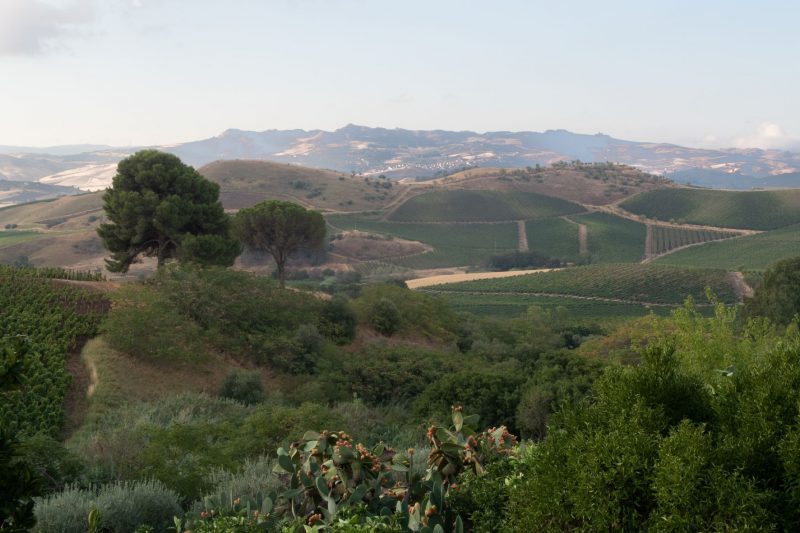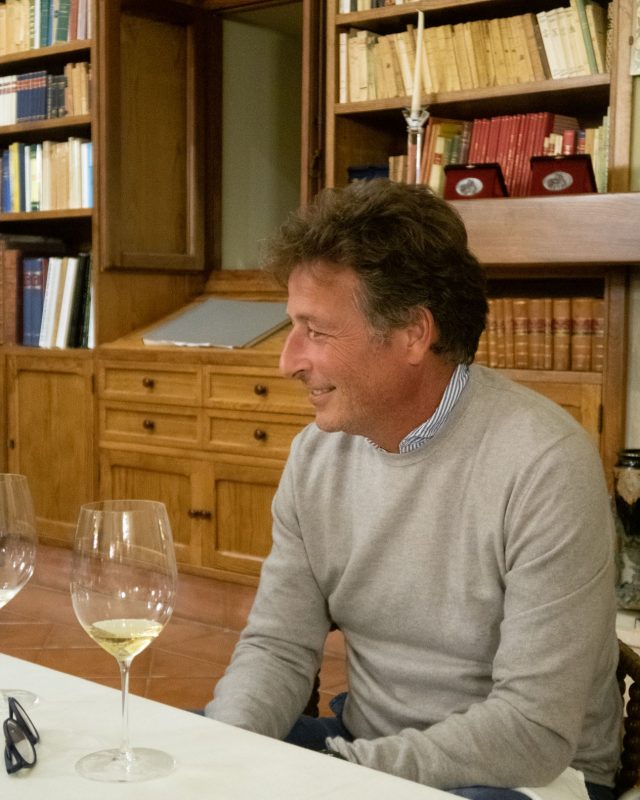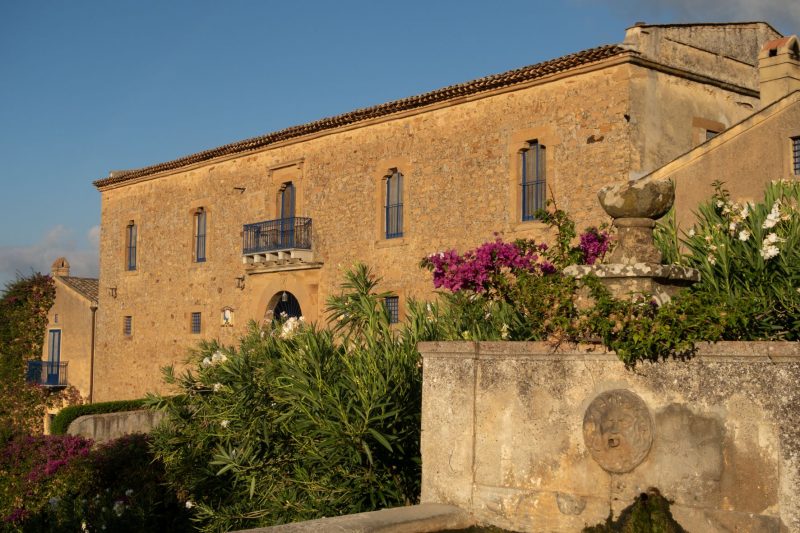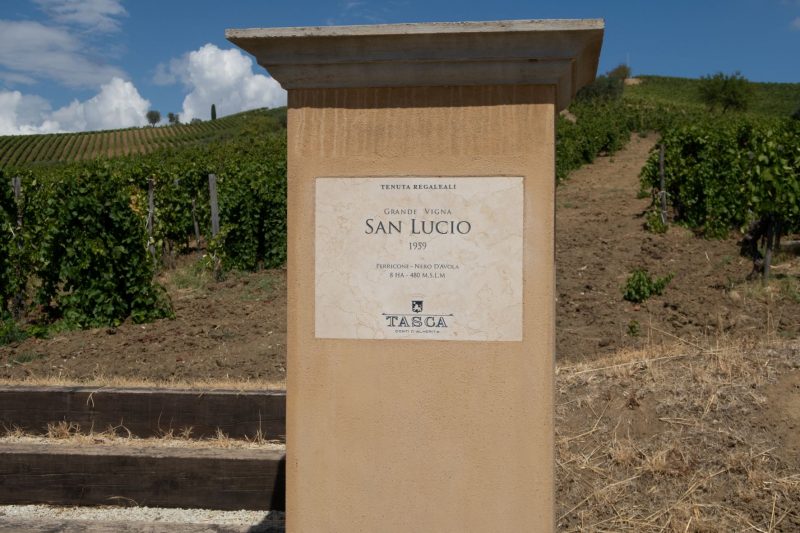Tenuta Regaleali is in the middle of nowhere. At least it seems that way on the drive from Palermo airport. As we exit the highway, night has fallen, and we still have a long trek on a bumpy, narrow, unpaved road. All I can see from my window are the stars and occasional lights from small, nearby hamlets.

One of five estates owned by the Tasca d’Almerita family, Tenuta Regaleali is the founding property purchased in 1830. The manor house is elegant, almost regal. Upon arriving, I am beckoned into the courtyard, centred around a decades-old magnolia tree. The heady scent of jasmine is intoxicating and the early September air surprisingly chilly – a blatant indication of the elevation.
The occasion of my visit is a vertical tasting of the estate’s flagship wine – Rosso del Conte. But first, the build-up…
I change from shorts and t-shirt into slacks and a sweater then join the casual welcome aperitivo. After snacks of lusty bone marrow and panelle (chickpea fritters) washed down by a fantastically savoury Grillo from the island of Mozia, we make our way inside for a nourishing dinner featuring the estate’s own produce.

As soon as the soup is served, eighth generation and CEO Alberto Tasca asks, “so, what do you think about sustainability?” This is clearly a subject that is close to Alberto’s heart. The company is one of the founding members of SOStain, Sicily’s sustainability certification which focuses on measuring and reducing a company’s environmental impact. It forbids chemical herbicides and includes regulations on water and carbon footprint,bottle weight, preservation of biodiversity as well as employee welfare and positive involvement with the local community.
I respond to Alberto’s question with my own query – asking what his definition of sustainability is. “It keeps changing,” he acknowledges. “The point isn’t just to preserve the environment; we also need to focus on humanity.” He references the Japanese business philosophy of Kaizen – one of constant improvement, being transparent in all processes and working to cancel all conflicts of interest. “It is a mix of knowledge that comes from measuring the impact of all your actions combined with a sense of responsibility.”
Alberto barely touches his plate throughout his discourse. Before I know it, dinner is being cleared and the most delectable cannoli, crammed with creamy ricotta and fresh pistachio is set before me. It’s served with Tasca’s Capofaro a passito of Malvasia di Lipari from the island of Salina which inspires sweet dreams.

The following morning, the beauty of the estate is revealed. I’d sure as heck do everything I could to preserve it too. We are in the northern central area of Sicily in the denomination of Sclafani Bagno. There are just three wineries here and Tasca d’Almerita’s nearest neighbour is Feudo Montoni. Until the 1940s, this was Sicily’s wheat basket. Alberto’s grandfather Count Giuseppe Tasca started to increase the estate’s original 30 hectares of vineyards in the 1950s.
An agricultural farm, the spacious property expands over six hills for a total of 538 hectares. Along with pastures, grain fields, olive groves, lakes and streams, it now counts 377 hectares of vineyard area. Rising from 400 to 900 metres, the lofty altitudes make for significant diurnal temperature differences – up to 20c between day and night.

A half-hour walk through vineyards lined with eucalyptus trees and perfectly ripe prickly pear leads to San Lucio. This 7-hectare plot provides the backbone of the estate’s Rosso del Conte. First planted in 1959 with Nero d’Avola and Perricone, it sits on cool, water-retaining clay with a warm sandy topsoil that reflects heat back to the vine during the night. The individually staked bush vines called alberello look like little trees.
Nero d’Avola has gained distinction as Sicily’s flagship grape. However, its expression changes depending where on this enormous island it grows. Tasca’s agronomist Davide Bacchiega explains that in the southwest the wines are soft and fruity while those in the southeast can have a bitterness to the tannins and ample alcohol. In central Sicily where Regaleali is, “Nero d’Avola has thick skins with lots of anthocyanins and gives vertical wines with higher acidity and freshness,” he says.
Perricone, on the other hand, is still a bit of a mystery. Once widely planted, it fell out of favour with growers long ago. “There are just 11 producers of Perricone today,” states Alberto who believes it might be the same grape as Grenache. Thus, the name ‘Guarnaccia’ for the estate’s delicious varietal Perricone which shows peppery, wild raspberry and herbal notes.
After checking out the vineyard, I am briefed for a tasting of nine vintages of Rosso del Conte spanning five decades. The vertical charts the evolution of this Nero d’Avola-led red from an evocative 1979 to the current 2016 release. “This is a return to Rosso del Conte’s original ‘recipe’,” Alberto says of the latter. He also opens two vintages of Riserva del Conte, Sicily’s first single vineyard wine. Initially produced in 1970, it was shelved for 40 years until Alberto revived the tradition with the 2010 vintage. While it too hails from San Lucio, it is the inverse of Rosso del Conte with Perricone supplemented by Nero d’Avola.
Like most verticals, this one has its peaks and valleys, but what is clear is the strong and distinct personality of the wines. Brimming with character, they are thoughtfully crafted without being over polished. They express the remote, exotic and munificent pocket of Tenuta Regaleali – and the strength of Sicily’s indigenous grapes.

Tenuta Regaleali Rosso del Conte, 1979
The 1979 is a poignant wine that speaks captivatingly of bygone days. As with the 1983 vintage, Nero d’Avola is co-fermented with approximately 10% Perricone then aged in 500-litre chestnut barrels for 10 months. At 42 years, it has held up exceptionally well. While the nose is delicate, savoury tea and dried exotic flowers emerge. Mid-weight yet enveloping, this hints at persimmon and pomegranate in both flavour and texture as background tannins still have that dryness and firmness. It has also retained its succulence and tension. It is beyond improving any further but a rare treat to drink now.
Tenuta Regaleali Rosso del Conte, 1983
While four years younger than the 1979, the 1983 presents much older. Aromas are very evolved – though the palate less so. The warmth and ripeness of the vintage are still apparent as prune cake and baked compote fill the mouth. Though lacking some vibrancy, it lingers with pleasant cocoa and compote nuances.
Tenuta Regaleali Rosso del Conte, 1992
In the early 90s, ageing switched to 350-litre French oak barrels, of which two-thirds were new. The 1992 blends grapes from San Lucio with the estate’s S. Anna and Ciminnita vineyards. Alas, this wine has seen better days. Aromas are fully oxidized and dominated by savoury bouillon. Mellow with soft melted tannins, the palate presents leather over a sour cherry core.
Tenuta Regaleali Rosso del Conte Contea di Sclafani DOC, 1998
A great phase for Rosso del Conte as the vines had reached a mature 40 years of age by 1998. And the wine is in a beautiful drinking window. It is impossible not to be seduced by aromas of exotic floral potpourri and the enveloping, caressing structure. The higher-than-average temperatures of the year manifest with a firm chewiness of tannins and dense, generous fruit. Yet a succulence runs through this with red plum and licorice lifting the finish. A great balance of maturity and vigour.
Tenuta Regaleali Rosso del Conte Contea di Sclafani DOC, 2001
The 2001 vintage marks the beginning of a transition era as Alberto Tasca starts to take the reins of his family’s estate. Here, there is just a dash of Perricone added to Nero d’Avola. Among my favourite wines of the vertical, it offers up expressive scents of tobacco and dried grapefruit peel. The palate is mid-weight with an elegant structure, although those tannins cling to the sides of the mouth. Plush relaxed fruit gains tension and brightness from the zesty acidity. There is still a lot of life here.
Tenuta Regaleali Rosso del Conte Contea di Sclafani DOC, 2006
Between 2004 and 2013, some of San Lucio old vines had to be replaced. As such, Rosso del Conte was supplemented with fruit from vineyards at similar altitudes. While Nero d’Avola still dominates, the 2006 is blended with a handful of other grapes including Syrah. It was a challenging summer – short with lots of rain. A developing but appealing bouquet exhibits polished wood, leather, prune and blackberry confiture. Velvety in structure with admirable fruit density this is lifted by citrusy acidity while nuances of eucalyptus, coffee and pleasantly bitter almond add further intrigue. Keep drinking this over the next 5 years.
Tenuta Regaleali Rosso del Conte Contea di Sclafani DOC, 2016
As of 2014, there was a return to Rosso del Conte’s original ‘recipe’ with Nero d’Avola and Perricone coming exclusively from the Santa Lucio vineyard. The most recent release, 2016 sees almost equal portions of the two grapes. It starts with red cherry, blood orange and licorice root. Sweet wood and cedary nuances lead into the palate which pops with an agrodolce, or sweet/sour nature. The tannins are relatively pliant wrapping around lavish youthful fruit. This is already liberal in its pleasure and will continue to charm for at least 12 years – though another year should see further integration of the wood. Ageing is in new French barriques for 18 months.
Tenuta Regaleali Riserva del Conte Contea di Sclafani DOC, 2010
The revival vintage of Riserva, which is distinguished from the Rosso by the blend – two parts Perricone to one part Nero d’Avola. Ageing is a lengthy 26 months in 500-litre chestnut barrels. This takes time to open, slowly revealing striking citrusy scents of pink grapefruit and blood orange. The palate demonstrates a riveting contrast of rich plum cake and tangy fresh nectarine with loads of sweet, dried herbs. Tannins are just starting to relax their grip. Finishes with a spicy, peppery twist.
Tenuta Regaleali Riserva del Conte Contea di Sclafani DOC, 2016
The second Riserva release in the new era, 2016 is firmly Perricone led at 60%, with 40% Nero d’Avola. The warm rather than hot year allowed for a long, slow ripening period and resulted in a shockingly modest 13% alcohol. Still somewhat rigid, even after an hour and a half in a decanter, this will require some patience. Eventually heady fragrances of orange blossom and savoury spice emerge. Linear, austere tannins are fleshed out with dense fruit and the sour-edges, pompelo acidity make you salivate. If 2010 is excellent, the 2016 is outstanding. Both are cellar worthy.
